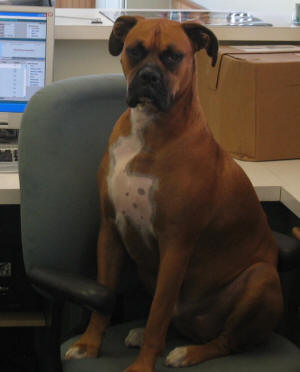Are hospital mascots or staff pets roaming in the hospital a hazard?
 One
of the benefits of working in the veterinary profession is the
ability to bring one’s pet to work. Likewise, many practices have
hospital mascots. In itself, these situations are not dangerous or
hazardous to the staff and OSHA does not have a regulation
prohibiting such activities. However, this issue is not that “black
and white.” If the hospital mascots or employees’ pets are allowed
to roam freely in the building, there may be a problem in the
making.
One
of the benefits of working in the veterinary profession is the
ability to bring one’s pet to work. Likewise, many practices have
hospital mascots. In itself, these situations are not dangerous or
hazardous to the staff and OSHA does not have a regulation
prohibiting such activities. However, this issue is not that “black
and white.” If the hospital mascots or employees’ pets are allowed
to roam freely in the building, there may be a problem in the
making.
Animals that roam freely in the facility can cause several safety problems for the staff. On the basic level, just having an animal laying in the wrong place at the wrong time is a hazard. If someone is walking and doesn’t see the animal laying on the floor, they can trip and injure themselves and the animal. OSHA does have a requirement for the business to maintain aisle ways and passages free and clear of obstructions - this would include the furry types!
Unrestrained animals in the practice have been known to show up in the wrong places and make difficult situations worse. For instance, if the hospital cat isn’t afraid of dogs, he or she is not likely to be concerned with a large dog in the waiting room or exam room. However, the dog may view “getting the kitty” as a game inalienably endowed to canines and as such would do just about anything to win. If a staff member were restraining the dog for say, venipuncture at the time, one can see the situation getting out of hand quickly. Likewise, an employee’s dog may scare a cat undergoing treatment to the point of the cat biting or scratching the staff member in an attempt to get away.
In today’s society (and certainly in our profession), we live with animals integrated into our homes and lives very intimately and that’s usually a good thing. However, the workplace is different and the veterinary hospital is not someone’s home. The veterinary hospital is a place where exceptionally large numbers of animals from all environments converge. The different pathogens that are introduced into the veterinary practice on a given day are one of the reasons we practice hand washing and other personal hygiene measures so diligently. By introducing one’s own pet to these pathogens, we may be increasing our risk of exposure to these pathogens when we interact with our pets or the hospital mascot. The old saying, “Familiarity breeds contempt” may need to be changed to “Familiarity breeds carelessness.” - We rarely wash our hands often enough and less so when we are dealing with our own pets.
No matter how well behaved the animal, simply their presence in some areas could be a potential violation of OSHA standards. Since OSHA requires the business to provide an area free from biological or chemical hazards if employees are allowed to eat or drink on the premises, logic holds that a cat or dog in the break room could be construed as introducing unwanted organisms. Again, the veterinary practice is not a home and some activities at one’s home would not be appropriate in public or at work with co-workers present.
Finally, there is the appearance aspect of allowing animals to roam freely in the building. Some clients are reluctant to patronize a place where their animal feels threatened or treated differently. It’s hard to explain to clients that they must restrain their pets in the waiting room to prevent fights, aggression, marked walls and the transmission of disease, when they witness the staff’s pets or hospital mascot allowed to run free.
All in all, if staff members are allowed to bring their pets to work, it would be best for all concerned if the pets were treated like any other visitor to the practice - either restrained or caged.
Did You Know...?
Animal inflicted injuries are the most common type of injury for veterinary workers. Bites and scratches are more common in the companion animal sector while crushing injuries to the arms or feet are most common in the large animal sector.
